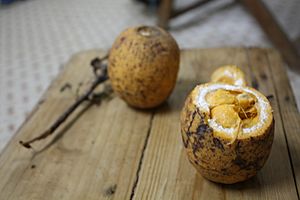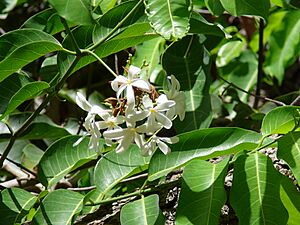Saba senegalensis facts for kids
Quick facts for kids Saba senegalensis |
|
|---|---|
 |
|
| Scientific classification | |
| Genus: |
Saba
|
| Species: |
senegalensis
|
The Saba senegalensis is a special plant that grows tasty fruits. People in some parts of Africa call it weda. It belongs to a plant family called Apocynaceae. This plant is found in the Sahel region, which is a dry area in sub-Saharan Africa.
You can find Saba senegalensis growing in many West African countries. It often grows near rivers and in forests. Countries like The Gambia, Guinea-Bissau, Burkina Faso, Senegal, Somalia, Mali, and Ivory Coast are home to this plant. It can grow in different ways. Sometimes it's a vine climbing other trees. Other times, it's a small bush or even a large tree.
The ICRISAT organization says that Saba senegalensis is a very useful food plant. It also helps to stop soil degradation, which is when soil becomes unhealthy. This is important for farming in rural Africa.
Contents
Delicious Fruit
The fruit of the Saba senegalensis has a hard, yellow skin. Inside, you'll find big seeds surrounded by a yellowish, soft pulp. This pulp has a nice sour taste. Many people say it tastes a bit like tamarind. Some even compare its flavor to a mango or a lemon. It's a popular snack!
Refreshing Drink
People living in the Sahel region often use this fruit to make a refreshing juice. It's a great way to cool down and enjoy the fruit's unique flavor.
How to Grow Saba senegalensis
Growing Saba senegalensis is easiest from its seeds. Here are some simple steps to help you get started.
Planting Seeds
First, get some seeds from the fruit. Soak them in warm water for a full day (24 hours). After soaking, plant the seeds directly into a special soil mix, like cactus soil. Be careful not to give them too much water. The seeds should start to sprout and grow into small plants within 2 to 4 weeks.
Growing from Cuttings
If you can find a live Saba senegalensis plant, you can also grow it from a cutting. Just cut a branch that is about 6 to 12 inches long. Plant this branch directly into the soil.
When Will it Fruit?
Once your plant is growing, it will usually start to produce fruit within 2 to 5 years. It's exciting to watch it grow and eventually enjoy its delicious fruit!
Where it Grows Best
Saba senegalensis likes warm weather. It grows best outdoors in places with warm climates, like USDA zones 10 and warmer. If you live in a colder area, you can still try to grow it. Just plant it in a pot and bring it inside your house during the cold winter months. This will protect it from the frost.
Common Names for Saba senegalensis
This plant has many different names, depending on the language spoken in the area. Here are some of its common names:
- In the Moore language: "Weda"
- In the Wolof language: "Madd"
- In Mandinka: "Kabaa"
- In the Bambara language: "Zaban"
- In the French language: "Liane saba"
- In Côte d'Ivoire: "Saba"
- In Sierra Leone Krio: "Malombo"
- In the Congo basin: "Malombo" or "Makalakonki"
- In Guinea Bissau, Kriolu language: "Foli lifanti"
- In Casamance, Senegal, Joola language: "Kuguissai"
- In Northern Nigeria, Hausa language: "Chiyo"
- In Somali: "Dhangalow"
- In Nigeria, Ibo language: "Utu"


